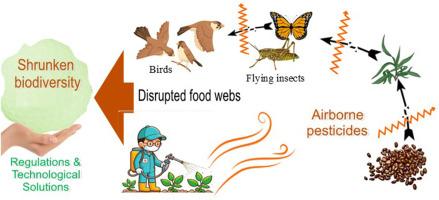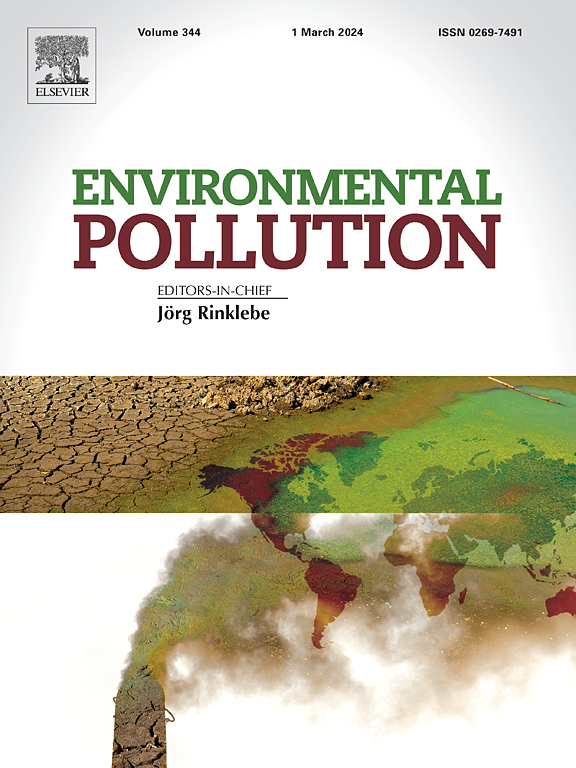Beyond the field: How pesticide drift endangers biodiversity
IF 7.3
2区 环境科学与生态学
Q1 ENVIRONMENTAL SCIENCES
引用次数: 0
Abstract
Airborne pesticide drift poses a substantial environmental threat in agriculture, affecting ecosystems far from the application sites. This process, in which up to 25% of applied pesticides are carried by air currents, can transport chemicals over hundreds or even thousands of kilometers. Drift rates peak during the summer months, reaching as high as 60%, and are influenced by various factors, including wind speed, temperature, humidity, and soil type. Pesticide volatilization is a significant concern, occurring 25 times more frequently than surface runoff. Under certain conditions, it can result in chemical losses of compounds like metolachlor and atrazine that are up to 150 times higher. These drifting pesticides have profound impacts on biodiversity, harming non-target plants, insects, fungi, and other organisms both near application sites and in distant ecosystems. Pesticide drift has been linked to over 50% reductions in wild plant diversity within 500 m of fields, reducing floral resources for pollinators. Despite growing evidence of these effects, the long-term consequences of airborne pesticides on biodiversity remain poorly understood, especially in complex field conditions with multiple pesticide applications. Addressing this requires urgent measures, such as improved meteorological tracking during applications, adoption of biopesticides, and integrated pest management strategies. This review highlights the pressing need for research to quantify airborne pesticides' ecological impacts, advocating for sustainable practices to mitigate environmental damage.


田间之外:农药漂移如何危及生物多样性
农药在空气中的漂移对农业环境造成了严重的威胁,影响了远离施用地点的生态系统。在这个过程中,高达25%的农药被气流携带,可以将化学物质输送数百甚至数千公里。漂移率在夏季达到峰值,高达60%,受风速、温度、湿度和土壤类型等多种因素的影响。农药挥发是一个重大问题,其发生频率是地表径流的25倍。在某些情况下,它会导致异丙甲草胺和阿特拉津等化合物的化学损失高达150倍。这些漂流农药对生物多样性产生了深远的影响,无论是在施用地点附近还是在遥远的生态系统中,它们都对非目标植物、昆虫、真菌和其他生物造成了伤害。农药漂移与农田500米范围内野生植物多样性减少50%以上有关,减少了传粉媒介的花卉资源。尽管有越来越多的证据表明这些影响,但空气传播农药对生物多样性的长期影响仍然知之甚少,特别是在多种农药使用的复杂田间条件下。解决这一问题需要采取紧急措施,如改进施用期间的气象跟踪、采用生物农药和病虫害综合管理战略。这篇综述强调了对空气中农药生态影响进行量化研究的迫切需要,倡导可持续的做法来减轻环境损害。
本文章由计算机程序翻译,如有差异,请以英文原文为准。
求助全文
约1分钟内获得全文
求助全文
来源期刊

Environmental Pollution
环境科学-环境科学
CiteScore
16.00
自引率
6.70%
发文量
2082
审稿时长
2.9 months
期刊介绍:
Environmental Pollution is an international peer-reviewed journal that publishes high-quality research papers and review articles covering all aspects of environmental pollution and its impacts on ecosystems and human health.
Subject areas include, but are not limited to:
• Sources and occurrences of pollutants that are clearly defined and measured in environmental compartments, food and food-related items, and human bodies;
• Interlinks between contaminant exposure and biological, ecological, and human health effects, including those of climate change;
• Contaminants of emerging concerns (including but not limited to antibiotic resistant microorganisms or genes, microplastics/nanoplastics, electronic wastes, light, and noise) and/or their biological, ecological, or human health effects;
• Laboratory and field studies on the remediation/mitigation of environmental pollution via new techniques and with clear links to biological, ecological, or human health effects;
• Modeling of pollution processes, patterns, or trends that is of clear environmental and/or human health interest;
• New techniques that measure and examine environmental occurrences, transport, behavior, and effects of pollutants within the environment or the laboratory, provided that they can be clearly used to address problems within regional or global environmental compartments.
 求助内容:
求助内容: 应助结果提醒方式:
应助结果提醒方式:


